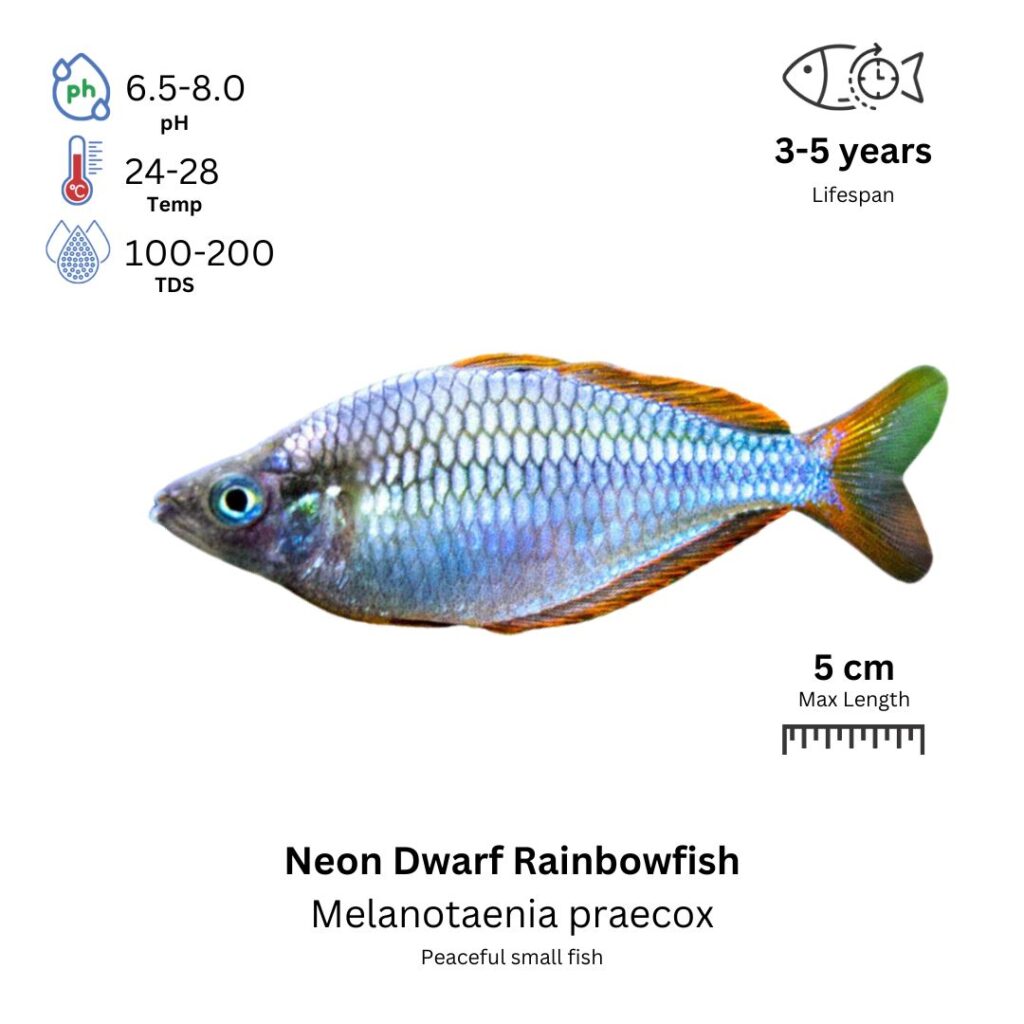Neon Dwarf Rainbowfish
Melanotaenia praecox

Description
The Neon Dwarf Rainbowfish is a small, vibrant fish known for its striking iridescent blue body, with a hint of orange or red on its fins, particularly during the breeding season. The male typically exhibits more intense coloration, with a bright blue body and a pronounced orange tint along the fins, while females are generally more subdued in color. These fish have a streamlined, elongated body shape and are known for their peaceful, active nature. Neon Dwarf Rainbowfish are very social and thrive in schools, often seen swimming together in the middle to upper areas of the tank. Their bright colors and lively behavior make them a popular choice for community aquariums.
Habitat Origin
Native to the freshwater rivers and streams in New Guinea, particularly in the northern and southern parts, where they inhabit clear, slow-moving waters with dense vegetation.
Aquarium
Ideal Number in Aquarium: At least 6 individuals, as they are schooling fish and feel more secure in groups.
Favorite Food

Neon Dwarf Rainbowfish are omnivores and will accept a variety of foods, including high-quality flake food, micro pellets, and live or frozen foods like brine shrimp, daphnia, and bloodworms. They also appreciate small amounts of plant matter, such as blanched spinach or algae wafers.
Behavior:
Neon Dwarf Rainbowfish are peaceful, active, and social fish that do well in schools. They are not aggressive and typically get along with other small, peaceful species. These fish are active swimmers, often found darting about the middle to upper areas of the tank. They do well in community aquariums and are non-territorial. During the breeding season, males will display more intense coloration, especially towards females.
Special Care:
These fish thrive in a well-planted aquarium with plenty of hiding spots, such as plants, driftwood, and rocks. They also require stable water conditions, so regular water changes and a good filtration system are necessary. Neon Dwarf Rainbowfish prefer a gentle water flow, mimicking their natural environment in slow-moving waters. A tank with a stable temperature and clean water will help them thrive.
Compatibility with Other Fish:
Yes, they are compatible with a wide variety of peaceful, small fish, such as other rainbowfish, tetras, rasboras, and shrimp. Due to their peaceful nature, they do well in community tanks but should not be housed with larger or aggressive species. They are especially suited for tanks with other schooling species, as they feel more secure in groups.
Breeding Tank Setup
It is highly recommended to use a separate breeding tank for Neon Dwarf Rainbowfish to protect eggs and fry from being eaten and to maintain stable water parameters. A 10-gallon (38-liter) tank is suitable for a breeding pair, while a 20-gallon (75-liter) tank works better for multiple pairs. Maintain water conditions at pH 6.5–7.5, temperature 24–28°C (75–82°F), and hardness 2–10 dGH. Use fine gravel or sand as substrate and include live plants like Java moss and Hornwort to provide surfaces for egg adhesion. Gentle sponge filters are ideal to maintain water quality without creating strong currents. Lighting should be moderate, following a 10–12 hour light/dark cycle.
Conditioning for Breeding
To bring Neon Dwarf Rainbowfish into breeding condition, feed a high-protein, varied diet. This includes quality flakes or pellets, along with live or frozen foods like brine shrimp, daphnia, and bloodworms. Supplement with vegetable matter such as finely chopped spinach or peas. Weekly 25–30% water changes are crucial to maintain optimal water quality. To induce spawning, perform a larger 50% water change and raise the temperature slightly to 28°C (82°F), mimicking rainy season cues that trigger breeding in the wild.
Spawning Process
Spawning usually takes place in the early morning after a water change. Males display intense coloration and courtship behavior, chasing and nudging females. Females scatter 30–100 small, sticky eggs, which adhere to plants, rocks, or substrate. To protect the eggs, remove the adults immediately after spawning, as they may eat the eggs. Eggs will hatch in 24–36 hours, depending on the temperature, and no parental care is provided after spawning.
Fry Care
Fry depend on their yolk sac for the first few days, after which they should be fed infusoria or liquid fry food. As they grow, introduce baby brine shrimp, microworms, and eventually finely crushed flakes. To maintain fry health, perform daily water changes of 10–20%, and ensure the temperature remains within 24–28°C (75–82°F). Avoid overfeeding, as excess food can foul the water and harm the fry. Stable, clean water is essential for their survival and development.
Additional Tips
Neon Dwarf Rainbowfish reach sexual maturity at 6–12 months. Males are slimmer, smaller, and more colorful, with vivid blue and red hues, while females are larger, rounder, and duller in color. For successful breeding, avoid sudden changes in water chemistry and maintain a calm, peaceful environment free from aggressive tank mates. Consistent care, clean water, and a nutritious diet will yield high-quality offspring and a smooth breeding process.
